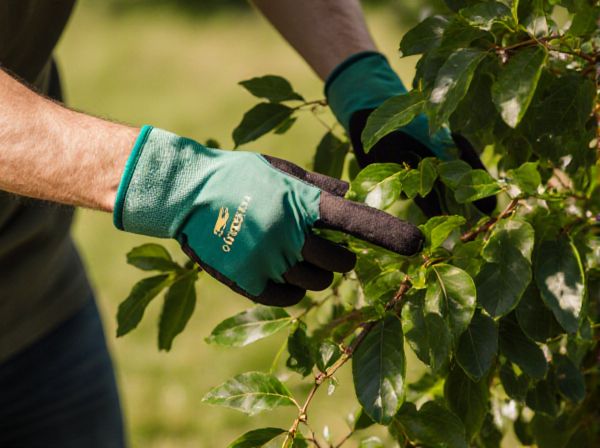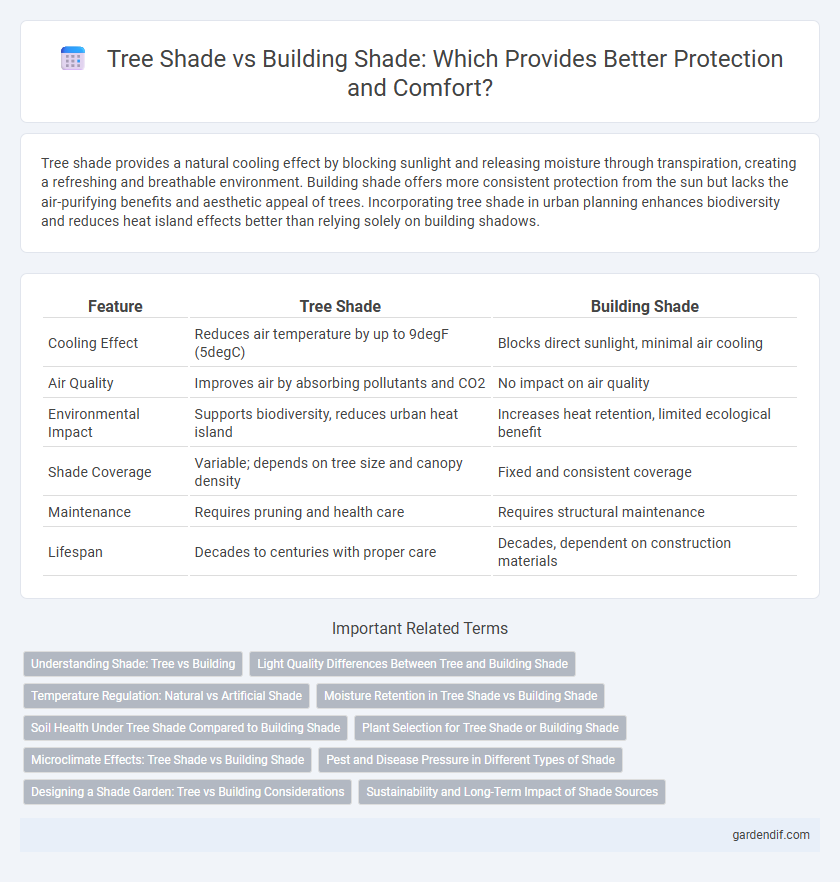
tree shade vs building shade Illustration
Tree shade provides a natural cooling effect by blocking sunlight and releasing moisture through transpiration, creating a refreshing and breathable environment. Building shade offers more consistent protection from the sun but lacks the air-purifying benefits and aesthetic appeal of trees. Incorporating tree shade in urban planning enhances biodiversity and reduces heat island effects better than relying solely on building shadows.
Table of Comparison
| Feature | Tree Shade | Building Shade |
|---|---|---|
| Cooling Effect | Reduces air temperature by up to 9degF (5degC) | Blocks direct sunlight, minimal air cooling |
| Air Quality | Improves air by absorbing pollutants and CO2 | No impact on air quality |
| Environmental Impact | Supports biodiversity, reduces urban heat island | Increases heat retention, limited ecological benefit |
| Shade Coverage | Variable; depends on tree size and canopy density | Fixed and consistent coverage |
| Maintenance | Requires pruning and health care | Requires structural maintenance |
| Lifespan | Decades to centuries with proper care | Decades, dependent on construction materials |
Understanding Shade: Tree vs Building
Tree shade provides natural cooling through evapotranspiration and blocks sunlight with dense foliage, promoting healthier air quality and reducing urban heat islands. Building shade, created by architectural structures, offers consistent and controllable protection from direct sunlight but lacks the environmental benefits of trees. Understanding these differences helps optimize urban planning for energy efficiency and improved microclimates.
Light Quality Differences Between Tree and Building Shade
Tree shade diffuses sunlight through leaves, creating dappled light that reduces glare and maintains natural color balance, enhancing visual comfort. Building shade blocks sunlight more uniformly, resulting in sharper contrast and cooler tones that can cause harsher shadows and reduced visibility. The spectral quality under tree shade tends to preserve a fuller light spectrum, while building shade often alters spectral distribution due to reflected and absorbed artificial materials.
Temperature Regulation: Natural vs Artificial Shade
Tree shade provides effective temperature regulation by blocking sunlight and releasing moisture through transpiration, which cools the surrounding air naturally. Building shade reduces heat by physically obstructing sunlight, but lacks the cooling benefits of evapotranspiration, often resulting in warmer ambient temperatures compared to natural shade. Studies show that tree shade can lower ground and air temperatures by up to 10degF (5-6degC), enhancing outdoor comfort more efficiently than artificial shade structures.
Moisture Retention in Tree Shade vs Building Shade
Tree shade enhances soil moisture retention by reducing evaporation rates through dense canopy cover and root system absorption, promoting a cooler microclimate. Building shade, in contrast, often causes uneven moisture distribution due to impermeable surfaces like concrete, which limit water infiltration and increase runoff. Tree shade also supports higher soil organic matter, further improving moisture retention compared to shaded areas near buildings.
Soil Health Under Tree Shade Compared to Building Shade
Soil health under tree shade benefits from increased organic matter, improved moisture retention, and enhanced microbial activity compared to building shade, which often leads to compacted, dry, and nutrient-poor soil conditions. Tree roots promote aeration and nutrient cycling, sustaining soil fertility, while buildings block sunlight and limit natural soil processes essential for maintaining soil quality. Consequently, tree-shaded soils support diverse soil biota and better structure, fostering healthier plant growth and ecosystem stability.
Plant Selection for Tree Shade or Building Shade
For effective tree shade, select broadleaf species such as oak or maple that provide dense, wide canopies to maximize cooling and UV protection. Building shade benefits from deciduous trees like elm or gingko, which offer seasonal shading while allowing sunlight in winter for passive solar heating. Consider growth rate, root structure, and maintenance needs to optimize shade impact and protect building foundations.
Microclimate Effects: Tree Shade vs Building Shade
Tree shade significantly cools the surrounding air through evapotranspiration, reducing surface temperatures by up to 10degF and improving urban microclimates. Building shade primarily blocks direct sunlight, lowering surface heat but lacking the cooling benefits of moisture release that trees provide. The combined use of tree and building shade maximizes thermal comfort by integrating passive cooling and shading strategies in urban design.
Pest and Disease Pressure in Different Types of Shade
Tree shade creates a microclimate that often reduces pest and disease pressure by promoting natural predator activity and limiting harmful sunlight exposure, whereas building shade can trap moisture, increasing the risk of fungal diseases. The diverse leaf litter under tree shade supports beneficial soil microbes that help suppress pathogens, contrasting with the more sterile environment found under building shade. Understanding these differences is crucial for integrated pest management strategies in urban and suburban landscapes.
Designing a Shade Garden: Tree vs Building Considerations
Designing a shade garden requires careful evaluation of tree shade and building shade to optimize light exposure and microclimate. Tree shade offers dappled light and natural cooling benefits, promoting diverse plant growth and enhancing biodiversity, while building shade provides consistent, often deeper shade but may alter airflow and soil moisture levels. Selecting appropriate plants depends on the type of shade, with trees supporting shade-tolerant species like ferns and hostas, whereas building shade may suit succulents or drought-resistant plants adapted to more stable but limited sunlight.
Sustainability and Long-Term Impact of Shade Sources
Tree shade offers significant sustainability benefits by enhancing air quality, reducing urban heat islands, and supporting biodiversity, making it a renewable and organic cooling source with a positive ecological footprint. Building shade, while effective for immediate thermal regulation, often depends on materials and energy use that can contribute to environmental degradation over time. Prioritizing tree shade in urban planning maximizes long-term environmental benefits, carbon sequestration, and energy savings compared to conventional building shade solutions.
tree shade vs building shade Infographic

 gardendif.com
gardendif.com